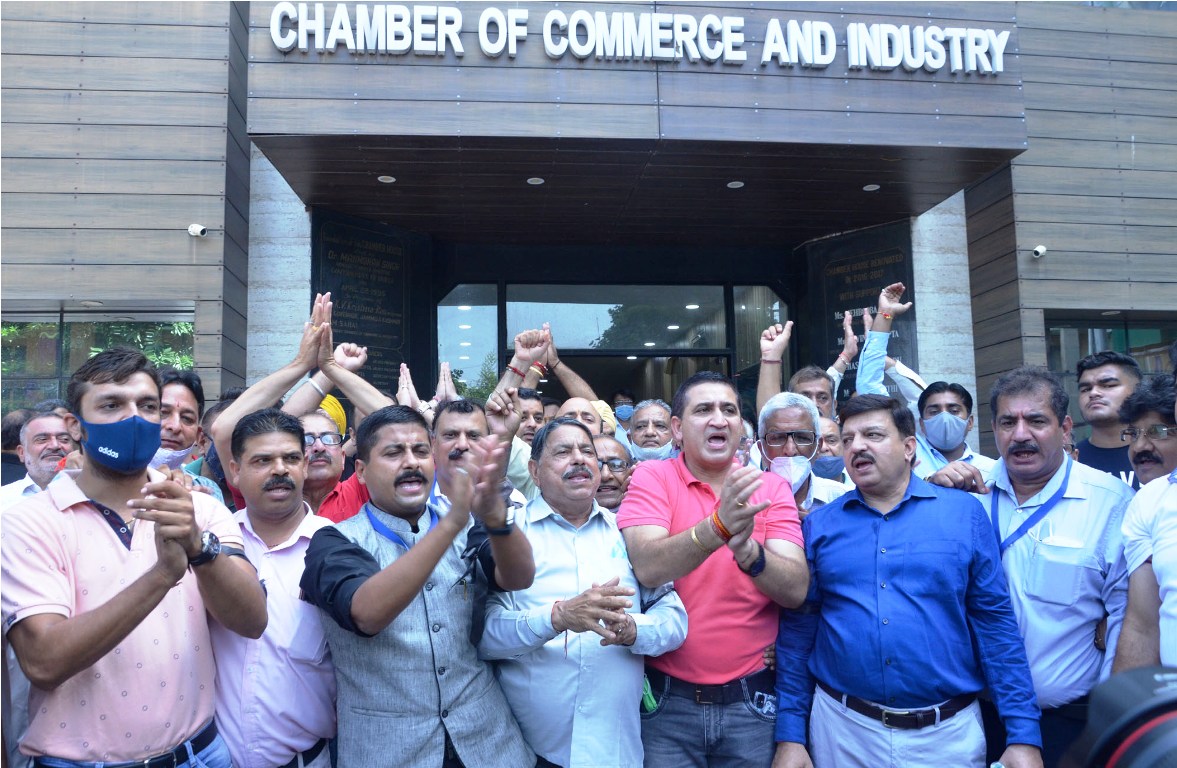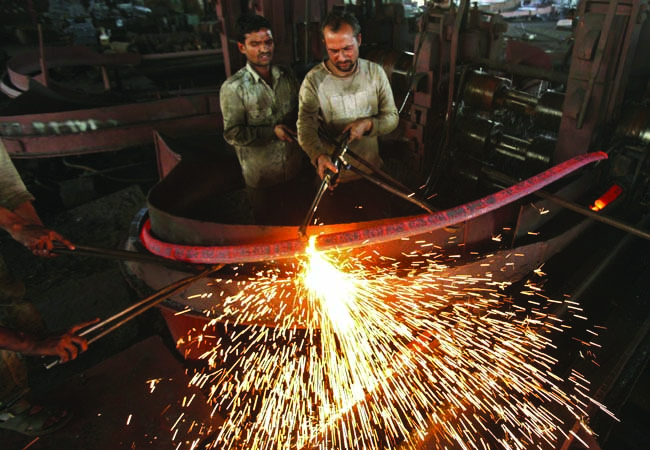With impressive concessions in hand, as the government is busy planning to get investors from the plains to change the industrial culture in a disadvantaged market, those who have been running the show in Jammu and Kashmir feel, they are pushed to uneven grounds, reports Masood Hussain

At a time when the government is planning huge investment in Srinagar and Jammu under the new industrial development policy, those owning small and medium industrial units insist the policymakers may require relooking at the document. This, they insist, is fundamental to helping the existing industrial investment survive.
“If the people who have already invested their fortune and blood are pushed to a survival crisis, how the new investor will come,” asked Shahid Kamili, the president of Federation of Chambers of Industry, Kashmir (FCIK). “We have been seeking certain corrections in the policy but so far we have not been able to get them to rethink.”
The industry across Jammu and Kashmir has always been the government’s priority. The policymakers always fought the inherent challenges that discouraged industry in the remote region – dislocation, distance from the raw material, market and ailing road connectivity between Kashmir and Jammu, and above all a small market within the confines of Ladakh, Jammu and Kashmir. The fragile security situation has been another major factor that played against a proper industrial culture, especially in Kashmir.
These interventions helped the manufacturing sector to a level that it became a contributor, almost double than the primary sector, to the state gross domestic product (GSDP). Against the surging service sector contribution of 55.92 per cent, the contribution of the primary sector to the SGDP is 16.18 per cent against 27.9 per cent coming from the industry.
In the last few years, a series of disruptive interventions at the policy level pushed the industry towards a freefall. It started with the introduction of the GST and was soon followed by the undoing of the Lakhinpur gateway as a physical barrier to the entry of merchandise, if not services. As the Covid19 pandemic took over, the consumption world over fell to a new low. Now the new industrial policy is being accused of an inherent bias towards the existing industry.
The New Policy
The new industrial policy is impressive, according to Jammu industrialist and former chieftain of the Jammu association, Annil Suri. “There are four major incentives that will make the fresh investment in the industry very attractive in Jammu and Kashmir,” Suri said. “The Greenfield projects will get a 30 per cent subsidy on investment for plant and machinery to a maximum of Rs 5 crore; they will get six per cent interest subvention on their term loans for initial years that will get their credit line almost free at not more than 2.5 per cent; and they will get GST linked concession of a payback of 300 per cent in 10 years on sale bills, which almost equals 30 per cent of their plant and machinery costs.”
This is in addition to the small industrial benefits that will continue flowing to the new and old industrial units as per routine. “This makes investment in Jammu and Kashmir very attractive,” Suri said.
Under the new policy – that has subsumed the 2017 policy – the government intends to offer Rs 24,800 crore incentives up to 2037 for new investments and substantial expansion of existing industries with an objective to create 450 thousand job opportunities.
Not Much
However, the existing industry in Jammu and Srinagar insists that only marginal benefits will go to the existing industrial network in Jammu and Kashmir. For the existing units, Suri said, there are three things.
“There is 5 per cent subsidy on working capital for a period of five years,” Suri said. “Then the package offers a turnover incentive of around three per cent that is being decided on an average of last three years, capped at around Rs 10 lakh. Besides, there is freight equalisation on a distance beyond 1000 km, which essentially means it is for markets beyond Delhi.”
The government, Kamili said will give us incentives on basis of the sales of the last three years but where are the sales? Jammu and Kashmir, he said, is literally closed since 2019 for one or the other reason.
Suri said they have met officials and made many representations asking them to reconsider the policy. “We have suggested that the turnover incentive may be delinked from previous year sales without any upper limit for micro industries with enhanced budgetary support,” Suri said. “A corpus be created for immediate disbursal within a timeline for quarterly disbursement of SGST refund as its reimbursement is delayed and denied on frivolous grounds with pick and choose policy. We also suggested that freight equalization incentive should be provided to MSME on sale of products outside Jammu and Kashmir and should be delinked from distance.”
Besides, they have flagged many other issues linked to lease and land and have identified various issues in the procedures. They have also demanded the extension of GST-linked incentives to the existing industries on the same pattern as are being given to the fresh investments. All earlier packages were extended to the existing units on a substantial expansion basis.
The Bigger Challenges
Even if all this would be agreed upon, insiders in the industrial eco-system of Jammu and Kashmir keep their fingers crossed over the survival of the existing setup. They say many other interventions coming from diverse appendages of the system pushed them to an ‘unfair pitch’.
The common market that was initially triggered by the rollout of the GST, industry players say was the first disadvantage. “The industry was technically tax-free in Jammu and Kashmir,” Kamili said. “We were getting 100 per cent remission in the VAT regime. The GST subsumed this all. Now, we are getting back 50 per cent of the GST charged on value addition after paying 18 per cent GST upfront on raw material and other things.” This, he said, is crippling the manufacturing in Kashmir because the investors have to maintain a 90-day inventory because of the situation and unstable road connectivity.
The bigger issue, industrialists point out, was the undoing of Lakhanpur. Before the gateway was done away with for a common market and a hassle-free movement of trade, every Jammu bound truck had to stop, to get the load verified and to pay two taxes – a toll tax and an entry tax.
“This essentially was a protection to the local manufacture,” Kamili said. “When we evaluate it now, we were getting a benefit of more than 25 per cent and this was enabling us to have an advantage over the items being imported from outside.”
Suri said this protection has opened the entire Jammu and Kashmir to non-local manufacturing and it has run really riot with the local industry. Even the government is losing an income, he said. “The only advantage is a paltry fall in the freight, maybe Rs 50 per ton but the losses are enormous especially in the low-cost high volume product basket,” Suri said. “Items being sold by major companies are cheaper than us and there is a syndicate of under-billing to the extent that in certain cases loaded trucks get in at odd hours to skip GST checks and that is seriously impacting the industry.” He said the abolition of the check-post has not in any way helped the consumer as the products are being sold at the same price as earlier. “The tragedy is that it has disrupted the marketing channels as the non-local manufacturers now directly supply to the retailer bypassing the main agent especially if the load is under-valued.”
Competing With Majors
The making of a single market has thrown up new challenges to the manufacturers because they believe they were already fighting a disadvantage. The industry in Jammu and Kashmir had a peculiar model – they were unlikely to produce for markets outside Jammu and Kashmir because they could not compete with majors in the industry. Even within Jammu and Kashmir, they would get a price preference in the supplies they would make to the government.
“In Jammu and Kashmir, almost sixty per cent of the small and medium units would manufacture for the government like electric poles, transformers, furniture, steel fabricated products and they all would supply the government through SICOP,” Kamili said. “The government withdrew this facility and opened the government purchase for everybody.”

There is GeM (Government e-Marketplace) portal for the government purchases that makes no distinction between a manufacturer and a trader and all the purchases are taking place from there. “I have invested into a plant that has taken my blood to manufacture an item,” Suri said. “In competition with me is a trader who has invested in a computer and a GST number. He sources the same item from cheap producers from somewhere and makes me unviable.” Suri said they have been asking the government that they must create a local GeM portal for local purchases with local suppliers in which the trader should not be around. “We have stakes, what is his stake?” he asked.
Insiders in the trade said that a recent purchase order for furniture has gone to Godrej as the local manufacturers could not supply on the prices that the giant offered. This has resulted in the local manufacturing facilities gradually moving out of business. “The process has just started and it will take some time till we lock our concerns,” one unitholder, running at least three facilities in Kashmir, said.
One Correction
Kamli said they have been able to convince the government to, for a start, cap some kind of purchases for the locals. “For a start, they have agreed that any purchase up to RS 5 lakh will be managed locally, orders have been issued and we will now build on this and take it to a respectable level,” Kamli said. “The other option is to ensure that the entire supply order must be distributed fairly within all competitors on the approved lowest rates.”
The debate is on, in Srinagar as well as in Jammu. Though the concerns are common, the approach is unlikely to build a consensus. Apart from problems getting converted into opportunities and vice versa between Srinagar and Jammu, politics is not so a dormant factor.










